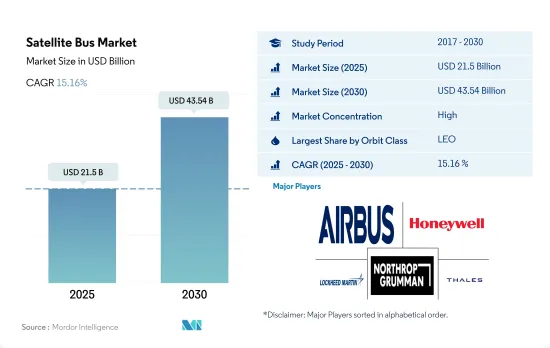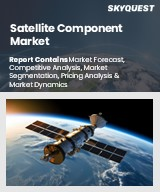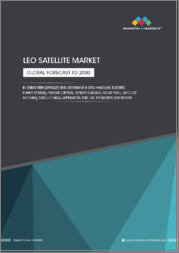
|
시장보고서
상품코드
1689943
위성 버스 시장 : 시장 점유율 분석, 산업 동향 및 통계, 성장 예측(2025-2030년)Satellite Bus - Market Share Analysis, Industry Trends & Statistics, Growth Forecasts (2025 - 2030) |
||||||
위성 버스 시장 규모는 2025년에 215억 달러로 추정되고, 2030년에는 435억 4,000만 달러에 이를 전망이며, 예측 기간(2025-2030년) 중 CAGR 15.16%를 보일 것으로 예측됩니다.

비용 효과, 배포 시간 단축, LEO 위성의 고급 기능이 시장 성장을 뒷받침
- 위성 버스 시장은 통신 및 네비게이션에서 원격 감지 및 과학 연구에 이르기까지 위성 기반 서비스에 대한 수요 증가에 따라 견인되고 있습니다. 비용 대비 효과가 높은 솔루션, 전개 시간의 단축, 고도의 기능에 대한 수요가, LEO, MEO, GEO 위성 전용의 혁신적인 위성 버스 솔루션의 개발을 뒷받침하고 있습니다.
- LEO 위성은 지구관측, 원격 감지, 과학 연구 등의 용도로 수요가 있습니다. LEO 위성용으로는 Boeing 502 Phoenix, Lockheed Martin LM400, Northrop Grumman GeoStar-3 등 다양한 기업이 다양한 버스 솔루션을 제공하고 있습니다. 이러한 버스는 지구 관측, 원격 감지, 과학 연구 등 다양한 LEO 용도를 지원하도록 설계되었습니다.
- MEO 위성은 통신 및 네비게이션과 같은 용도 분야에 사용됩니다. MEO 위성의 수요는 개선된 내비게이션 능력과 고도의 이미지 기술의 필요성에 의해 견인되고 있습니다. Airbus Defence and Space, Boeing, Lockheed Martin 등의 기업은 Airbus Eurostar Neo, Boeing 702MP, Lockheed Martin LM 2100 등 통신 및 항법 미션용 선진 솔루션을 제공하고 있습니다.
- GEO 위성 수요는 대용량 데이터 전송, 세계 커버리지, 고화질 방송 기능에 대한 요구에 의해 견인되고 있습니다. GEO 궤도에서는 Boeing, Lockheed Martin, Maxar Technologies 등이 시장의 주요 기업입니다. 이들 기업은 Boeing 702, Lockheed Martin A2100, Maxar Technologies 1300-class 등 통신 및 방송 미션을 위한 혁신적인 솔루션을 제공하고 있습니다. 이 버스들은 위성을 이용한 서비스에 장기간 안정적인 서비스를 제공하도록 설계되어 있습니다.
제조 및 발사 위성수의 급증이 시장에 플러스의 영향
- 세계의 위성 제조 시장은 현대 사회에서 중요한 역할을 하는 역동적이고 변화가 치열한 산업입니다. 이 산업에는, 소형의 큐브형 위성으로부터 대형의 지구 관측 위성이나 통신 위성까지, 폭넓은 종류의 위성을 설계, 제조 및 발사하고 있는 기업이 포함됩니다.
- 이 업계는 통신, 항법, 지구관측 등의 위성 서비스에 대한 수요가 높아지고, 공적기관 및 민간 기관에 의한 우주에 대한 액세스 증가 등 다양한 요인에 의해 견인되고 있습니다. 그 결과, 이 업계는 최근 현저한 성장을 이루고 있어 신규 참가 기업이나 기존 기업이 그 능력을 확대하고 있습니다.
- 위성제조는 첨단재료, 일렉트로닉스, 소프트웨어 등 많은 기술을 구사한 복잡한 프로세스입니다. 이 분야의 기업은 이러한 기술을 깊이 이해하고 우주의 가혹한 조건을 견디는 고도의 시스템에 통합할 수 있어야 합니다. 주요 위성업체로는 Airbus Defense and Space, Boeing Company, Lockheed Martin, Thales Alenia Space 등이 있습니다.
- 북미와 유럽은 이 업계에서 보다 확립된 시장이며, 아시아태평양은 성장 기회의 보다 유리한 시장입니다. 2017-2022년 5월까지 전 세계적으로 약 4,300기의 위성이 제조 및 발사되었습니다. 세계 위성 제조 시장은 위성 서비스에 대한 수요가 높아지고 우주에 대한 접근이 확대됨에 따라 성장과 혁신이 예측됩니다.
위성버스 시장 동향
소형 위성이 시장 수요를 환기하는 자세
- 우주선의 질량별 분류는 위성을 궤도로 발사하기 위한 로켓의 크기와 비용을 결정하는 주요 지표 중 하나입니다. 북미에서는 2017-2022년 사이에 약 45대 이상의 대형 위성이 발사되어 북미 조직이 소유하고 있습니다. 발사된 80대 이상의 중형 위성은 북미 조직에 의해 운용되었습니다. 약 2,900개 이상의 소형 위성이 이 지역에서 제조되어 발사되었습니다.
- 유럽은 최근 몇 년 동안 현저한 성장을 이루었는데, 이는 주로 다른 질량의 위성에 대한 수요 증가에 의한 것입니다. 위성 질량은 유럽의 위성 제조 시장에 영향을 미치는 가장 중요한 요인 중 하나입니다. 위성의 종류에 따라 다른 질량을 필요로 하며 로켓 시장에 영향을 미치기 때문입니다. 예를 들어, 2017-2022년 사이에 이 지역에서는 총 569기의 위성이 발사되었습니다. 이들 569대의 위성 가운데 451대의 위성이 궤도에 올라 소형 위성이 가장 큰 점유율을 차지했고 이어 44대의 초소형 위성, 37대의 대형 위성, 16대의 중형 위성, 7대의 초소형 위성이 뒤를 이었습니다.
- 위성 제조는 첨단 위성 기능에 대한 수요가 증가함에 따라 최근 아시아태평양에서 점점 더 중요한 산업이 되고 있습니다. 아시아태평양 지역에서 제조되고 있는 위성의 질량 범위는 크게 다르며, 이것이 시장 성장에 큰 영향을 주고 있습니다. 예를 들어, 2017-2022년 사이에 이 지역에서는 총 370대의 위성이 발사되었습니다. 그 중 궤도에 발사된 위성은 130대로 초소형 위성이 가장 큰 점유율을 차지하였고, 그 다음으로 대형 위성 75대, 초소형 위성 63대, 중형 위성 60대, 소형 위성 42대였습니다.
시장 투자 기회는 우주 개발에 대한 지출 증가
- 북미에서는 우주 개발에 대한 정부 지출이 2021년에 사상 최고인 약 1,030억 달러에 이르렀습니다. 이 지역은, 세계 최대의 우주 기관인 NASA의 존재에 의해, 우주 혁신 및 연구의 진원지가 되고 있습니다. 2022년 미국 정부는 그 우주 프로그램에 약 620억 달러를 지출하여 세계에서 가장 우주 개발비가 많은 나라가 되었습니다. 예를 들어, 2023년 2월까지 NASA는 연구 보조금으로 3억 3,300만 달러를 분배했습니다. 2022년, 미국 정부는 우주 프로그램에 약 620억 달러를 지출했습니다.
- 유럽 국가들은 우주 분야에서의 다양한 투자의 중요성을 인식하고 있으며, 세계 우주 산업에서 경쟁력을 유지하고 혁신을 유지하기 위해 우주 활동과 기술 혁신에 대한 지출을 늘리고 있습니다. 2022년 11월, 유럽 우주 기관(ESA)은 지구관측에서 유럽의 리드를 유지하고, 항법 서비스를 확대하고, 미국과의 탐사 파트너가 되기 위해 향후 3년간 우주 자금을 25% 증액할 것을 제안했다고 발표했습니다. 유럽우주기구(ESA)는 22개국에 대해 2023-2025년 185억 유로의 예산을 지지하도록 요구하고 있습니다. 독일, 프랑스, 이탈리아가 주요 기여국입니다.
- 아시아태평양에서 우주 관련 활동이 증가함에 따라 일본 예산안에 따르면 2022년 우주 예산은 14억 달러를 넘었고, 이는 H3 로켓, 기술 시험 위성 9호, 정보 수집 위성(IGS) 계획의 개발을 포함합니다. 마찬가지로 2022년도 인도 우주개발 예산안은 18억 3,000만 달러였습니다. 2022년 한국의 과학정보통신부는 인공위성, 로켓 및 기타 주요 우주 장비 제조에 6억 1,900만 달러의 우주 예산을 기록했다고 발표했습니다.
위성 버스 산업 개요
위성 버스 시장은 상당히 통합되어 있으며 상위 5개사에서 71%를 차지하고 있습니다. 이 시장의 주요 기업은 Airbus SE, Honeywell International Inc., Lockheed Martin Corporation, Northrop Grumman Corporation, Thales 등이 있습니다.(순부동)
기타 혜택
- 엑셀 형식 시장 예측(ME) 시트
- 3개월의 애널리스트 서포트
목차
제1장 주요 요약 및 주요 조사 결과
제2장 보고서 오퍼
제3장 서문
- 조사의 전제조건 및 시장 정의
- 조사 범위
- 조사 방법
제4장 주요 산업 동향
- 위성의 소형화
- 위성 질량
- 우주 개발에 대한 지출
- 규제 프레임워크
- 세계
- 호주
- 브라질
- 캐나다
- 중국
- 프랑스
- 독일
- 인도
- 이란
- 일본
- 뉴질랜드
- 러시아
- 싱가포르
- 한국
- 아랍에미리트(UAE)
- 영국
- 미국
- 밸류체인 및 유통채널 분석
제5장 시장 세분화
- 용도별
- 통신
- 지구관측
- 네비게이션
- 우주 관측
- 기타
- 위성 질량별
- 10-100kg
- 100-500kg
- 500-1000kg
- 10kg 미만
- 1000kg 이상
- 궤도 클래스별
- GEO
- LEO
- MEO
- 최종 사용자별
- 상업
- 군사 및 정부
- 기타
- 지역별
- 아시아태평양
- 유럽
- 북미
- 세계 기타 지역
제6장 경쟁 구도
- 주요 전략 동향
- 시장 점유율 분석
- 기업 상황
- 기업 프로파일
- Airbus SE
- Ball Corporation
- Honeywell International Inc.
- Lockheed Martin Corporation
- Nano Avionics
- NEC
- Northrop Grumman Corporation
- OHB SE
- Sierra Nevada Corporation
- Thales
제7장 CEO에 대한 주요 전략적 질문
제8장 부록
- 세계 개요
- 개요
- Porter's Five Forces 분석 프레임워크
- 세계의 밸류체인 분석
- 시장 역학(DROs)
- 정보원 및 참고문헌
- 도표 일람
- 주요 인사이트
- 데이터 팩
- 용어집
The Satellite Bus Market size is estimated at 21.5 billion USD in 2025, and is expected to reach 43.54 billion USD by 2030, growing at a CAGR of 15.16% during the forecast period (2025-2030).

Cost-effectiveness, faster deployment times, and advanced capabilities of LEO satellites aids the market growth
- The satellite bus market is driven by the increasing demand for satellite-based services, with applications ranging from communication and navigation to remote sensing and scientific research. The demand for cost-effective solutions, faster deployment times, and advanced capabilities is driving the development of innovative satellite bus solutions for LEO, MEO, and GEO satellites.
- LEO satellites are in demand for applications such as Earth observation, remote sensing, and scientific research. For LEO satellites, various companies offer a range of bus solutions, including the Boeing 502 Phoenix, the Lockheed Martin LM 400, and the Northrop Grumman GeoStar-3. These buses are designed to support a range of LEO applications, such as Earth observation, remote sensing, and scientific research.
- MEO satellites are used for applications such as communication and navigation. The demand for MEO satellites is driven by the need for improved navigation capabilities and advanced imaging technologies. Companies like Airbus Defence and Space, Boeing, and Lockheed Martin offer advanced solutions for communication and navigation missions, including the Airbus Eurostar Neo, the Boeing 702MP, and the Lockheed Martin LM 2100.
- The demand for GEO satellites is driven by the need for high-capacity data transmission, global coverage, and high-quality broadcasting capabilities. For GEO orbit, key players in the market include Boeing, Lockheed Martin, and Maxar Technologies. These companies offer innovative solutions for communication and broadcasting missions, including the Boeing 702, the Lockheed Martin A2100, and the Maxar Technologies 1300-class. These buses are designed to provide long-term, stable service for satellite-based services
The surge in the number of satellites manufactured and launched has positively impacted the market
- The global satellite manufacturing market is a dynamic and rapidly changing industry that plays an important role in modern society. This industry includes companies that design, manufacture, and launch a wide range of satellites, from small cubes to large Earth observation and communication satellites.
- The industry is driven by various factors, including growing demand for satellite services such as communications, navigation, and Earth observation, and increasing accessibility to space for public and private organizations. As a result, the industry has seen significant growth in recent years, with new players entering the market and established companies expanding their capabilities.
- Satellite manufacturing is a complex process with many technologies, including advanced materials, electronics, and software. Companies in this field must have a deep understanding of these technologies and be able to integrate them into sophisticated systems that can withstand the harsh conditions of space. Major satellite manufacturers include Airbus Defense and Space, The Boeing Company, Lockheed Martin, and Thales Alenia Space.
- North America and Europe are more established markets in the industry, while Asia-Pacific is a more lucrative market for growth opportunities. From 2017 to May 2022, around 4300 satellites were manufactured and launched globally. The global satellite manufacturing market is projected to grow and innovate as demand for satellite services grows and space access expands.
Global Satellite Bus Market Trends
Small satellites are poised to generate the demand in the market
- The classification of spacecraft by mass is one of the main metrics for determining the launch vehicle size and cost of launching satellites into orbit. In North America, during 2017-2022, around 45+ large satellites launched were owned by North American organizations. More than 80 medium-sized satellites launched were operated by North American organizations. Around 2900+ small satellites were manufactured and launched in this region.
- Europe has witnessed significant growth in recent years, primarily driven by the increasing demand for different satellite masses. Satellite mass is one of the most critical factors that influence the satellite manufacturing market in Europe. This is because different types of satellites require different masses, influencing the launch vehicle market. For instance, during 2017-2022, a total of 569 satellites were launched in the region. Of these 569 satellites, minisatellites accounted for the largest share, with 451 satellites launched into orbit, followed by 44 nanosatellites, 37 large satellites, 16 medium size satellites, and seven microsatellites.
- Satellite manufacturing has become an increasingly important industry in Asia-Pacific in recent years, driven by the need to meet the growing demand for advanced satellite capabilities. The range of satellite mass that is being manufactured in Asia-Pacific varies significantly, and this has a significant impact on the growth of the market. For instance, during 2017-2022, a total of 370 satellites were launched in the region. Of that, microsatellites accounted for the largest share, with 130 satellites launched into orbit, followed by 75 large satellites, 63 nanosatellites, 60 medium size satellites, and 42 minisatellites.
Investment opportunities in the market are increasing spending on space programs
- In North America, government expenditure for space programs hit a record of approximately 103 billion in 2021. The region is the epicenter of space innovation and research, with the presence of the world's biggest space agency, NASA. In 2022, the US government spent nearly USD 62 billion on its space programs, making it the highest spender on space in the world. For instance, till February 2023, NASA distributed USD 333 million as research grants. In 2022, the US government spent nearly USD 62 billion on its space programs.
- European countries are recognizing the importance of various investments in the space domain and are increasing their spending on space activities and innovation to stay competitive and innovative in the global space industry. On this note, in November 2022, ESA announced that it proposed a 25% boost in space funding over the next three years designed to maintain Europe's lead in Earth observation, expand navigation services and remain a partner in exploration with the United States. The European Space Agency (ESA) is asking its 22 nations to back a budget of EUR 18.5 billion for 2023-2025. Germany, France, and Italy are the major contributors.
- Considering the increase in space-related activities in the Asia-Pacific region, in 2022, according to the draft budget of Japan, the space budget of the country was over USD 1.4 billion, which includes the development of the H3 rocket, Engineering Test Satellite-9, and the nation's Information Gathering Satellite (IGS) program. Similarly, the proposed budget for India's space programs for FY22 is USD 1.83 billion. In 2022, South Korea's Ministry of Science and ICT announced a space budget of USD 619 million for manufacturing satellites, rockets, and other key space equipment.
Satellite Bus Industry Overview
The Satellite Bus Market is fairly consolidated, with the top five companies occupying 71%. The major players in this market are Airbus SE, Honeywell International Inc., Lockheed Martin Corporation, Northrop Grumman Corporation and Thales (sorted alphabetically).
Additional Benefits:
- The market estimate (ME) sheet in Excel format
- 3 months of analyst support
TABLE OF CONTENTS
1 EXECUTIVE SUMMARY & KEY FINDINGS
2 REPORT OFFERS
3 INTRODUCTION
- 3.1 Study Assumptions & Market Definition
- 3.2 Scope of the Study
- 3.3 Research Methodology
4 KEY INDUSTRY TRENDS
- 4.1 Satellite Miniaturization
- 4.2 Satellite Mass
- 4.3 Spending On Space Programs
- 4.4 Regulatory Framework
- 4.4.1 Global
- 4.4.2 Australia
- 4.4.3 Brazil
- 4.4.4 Canada
- 4.4.5 China
- 4.4.6 France
- 4.4.7 Germany
- 4.4.8 India
- 4.4.9 Iran
- 4.4.10 Japan
- 4.4.11 New Zealand
- 4.4.12 Russia
- 4.4.13 Singapore
- 4.4.14 South Korea
- 4.4.15 United Arab Emirates
- 4.4.16 United Kingdom
- 4.4.17 United States
- 4.5 Value Chain & Distribution Channel Analysis
5 MARKET SEGMENTATION (includes market size in Value in USD, Forecasts up to 2030 and analysis of growth prospects)
- 5.1 Application
- 5.1.1 Communication
- 5.1.2 Earth Observation
- 5.1.3 Navigation
- 5.1.4 Space Observation
- 5.1.5 Others
- 5.2 Satellite Mass
- 5.2.1 10-100kg
- 5.2.2 100-500kg
- 5.2.3 500-1000kg
- 5.2.4 Below 10 Kg
- 5.2.5 above 1000kg
- 5.3 Orbit Class
- 5.3.1 GEO
- 5.3.2 LEO
- 5.3.3 MEO
- 5.4 End User
- 5.4.1 Commercial
- 5.4.2 Military & Government
- 5.4.3 Other
- 5.5 Region
- 5.5.1 Asia-Pacific
- 5.5.2 Europe
- 5.5.3 North America
- 5.5.4 Rest of World
6 COMPETITIVE LANDSCAPE
- 6.1 Key Strategic Moves
- 6.2 Market Share Analysis
- 6.3 Company Landscape
- 6.4 Company Profiles (includes Global Level Overview, Market Level Overview, Core Business Segments, Financials, Headcount, Key Information, Market Rank, Market Share, Products and Services, and Analysis of Recent Developments).
- 6.4.1 Airbus SE
- 6.4.2 Ball Corporation
- 6.4.3 Honeywell International Inc.
- 6.4.4 Lockheed Martin Corporation
- 6.4.5 Nano Avionics
- 6.4.6 NEC
- 6.4.7 Northrop Grumman Corporation
- 6.4.8 OHB SE
- 6.4.9 Sierra Nevada Corporation
- 6.4.10 Thales
7 KEY STRATEGIC QUESTIONS FOR SATELLITE CEOS
8 APPENDIX
- 8.1 Global Overview
- 8.1.1 Overview
- 8.1.2 Porter's Five Forces Framework
- 8.1.3 Global Value Chain Analysis
- 8.1.4 Market Dynamics (DROs)
- 8.2 Sources & References
- 8.3 List of Tables & Figures
- 8.4 Primary Insights
- 8.5 Data Pack
- 8.6 Glossary of Terms

















